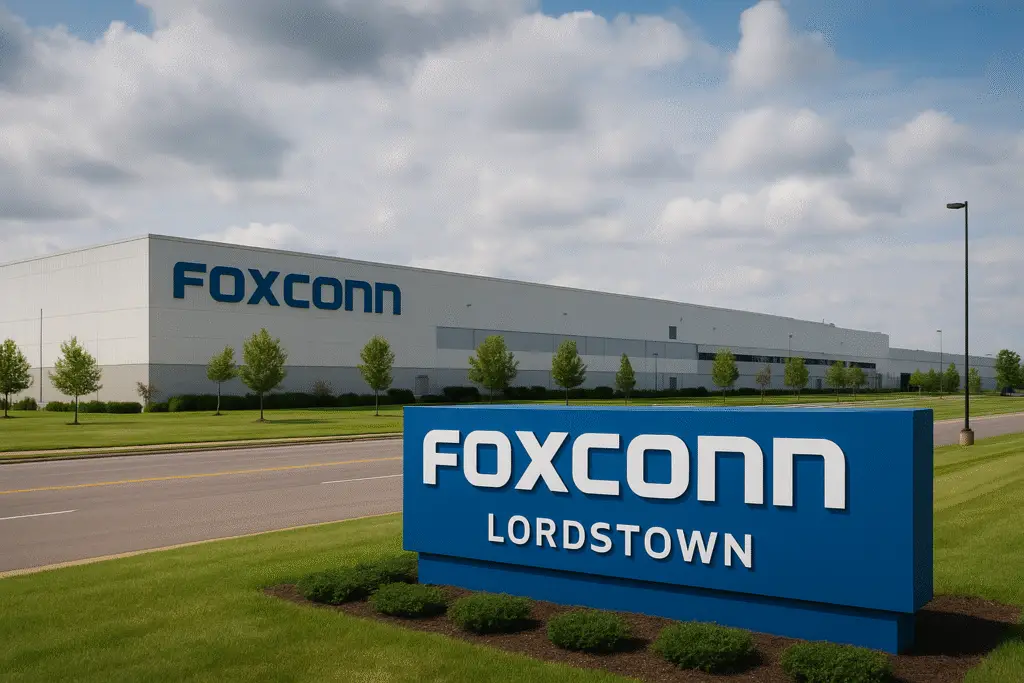Factories are changing, They are no longer just about making cars or consumer gadgets. Today, they are becoming the engines that build the hardware powering artificial intelligence. The new deal in Lordstown, Ohio, where Foxconn sold its massive factory to SoftBank but will continue operating it to build AI servers, is a powerful signal of this shift.
This move highlights the growing importance of Foxconn AI and shows how artificial intelligence is reshaping industries, jobs, and even communities. SoftBank acquired the Lordstown plant for around $375 million and brought Foxconn on board to keep running the facility. The focus is now on producing AI servers and advanced data equipment instead of electric cars.
Why does this matter? Because it shows a new trend: the global demand for AI hardware is exploding. Companies like Foxconn are shifting resources away from traditional electronics and moving toward AI infrastructure.
In other words, the future of manufacturing lies not in smartphones or cars, but in the massive server racks and cooling systems needed to power artificial intelligence.
This is where Foxconn AI becomes the new face of industrial growth.
The Lordstown factory once symbolized America’s hope for electric vehicles. However, after setbacks in the EV market, the facility was in danger of becoming another empty promise. With this new deal, Foxconn and SoftBank are giving it a second life.
Instead of producing EVs, the plant will now assemble AI servers. These servers are the backbone of modern AI housing GPUs, processors, and cooling systems that make machine learning possible. For the community, this means stability, long term jobs, and a role in the global AI economy.
Building AI servers is faster and less risky than trying to revive an EV line. It requires advanced skills but can scale much quicker. This makes the deal not just smart but also future proof.
From Car Assembly to AI Hardware
Walking into a modern AI factory is a very different experience compared to an auto plant. Instead of large machines stamping steel and welding car frames, you’ll see:
GPU trays and processors being carefully installed. High density racks wired with cooling systems. Technicians running stress tests to make sure the servers can handle nonstop workloads.
This means local workers are being retrained. A mechanic who once assembled car doors might now test cooling systems for AI servers. An electrician who wired vehicles will now work on three phase power distribution for racks.
The jobs are still industrial but they are more technical, more future oriented, and often better paid. Industry analysts point out two key reasons this deal matters.
AI servers are now one of the fastest growing sectors in tech. Foxconn is seeing revenue from AI hardware rival its smartphone business. The Ohio site has the land, logistics, and most importantly access to power needed for AI manufacturing.
Experts also warn that the real challenge lies in power consumption. AI data centers are energy hungry, and factories like this must innovate in cooling and efficiency to stay competitive.
Local Suppliers Enter the AI Game
Think of a small Ohio company that once made parts for car factories. With the Lordstown plant shifting to AI, that same company might now build chassis components, liquid cooling systems, or housing for servers.
This is more than just a supply chain shift it’s an upgrade. Instead of fighting for low margin auto contracts, these suppliers can now move into the high value world of Foxconn AI hardware. That’s long term stability for local businesses.
For workers, this transition feels different. Instead of worrying about layoffs from failing EV projects, there’s excitement about being part of something growing.
A plant engineer may now spend days testing server cooling systems instead of chasing production targets for cars. An electrician might learn new skills around high capacity racks instead of just vehicle wiring.
The sense on the ground is that these jobs are not just about building products they’re about building the future.
Energy, Policy, and Beyond
AI’s hunger for power is forcing policymakers to rethink infrastructure. Large factories like this one will influence. New substations and transmission upgrades.
Governments are now offering incentives not only for cars and chips but also for AI hardware. Suppliers, training programs, and universities are pivoting toward AI focused skills.
This makes the Foxconn AI factory more than just a business deal it’s a signal that entire regions are being reshaped by artificial intelligence.
Risks to Keep in Mind
While the deal is exciting, risks remain, Tariffs or export restrictions could complicate global supply chains. AI growth demands enormous energy, and delays in building substations could slow down production.
Still, this deal looks more secure than past attempts in Lordstown because it is anchored by real demand from global AI projects. Jobs in assembly, quality control, and logistics. Specialized roles in liquid cooling, power distribution, and firmware testing.
Research and innovation hubs attached to the plant, focusing on next generation AI systems. This means the workforce won’t just have jobs it will have pathways to grow alongside AI.
A Template for the Future
The Lordstown deal shows how manufacturing is being rewritten for the AI era. Instead of empty promises about electric cars, Ohio now has a clear role in building the infrastructure that powers artificial intelligence.
The formula is simple but powerful, Redevelop unused factories, Partner with tech giants. Retrain workers for new, high tech roles Align with energy and policy needs.
If this model succeeds, other regions in the U.S and around the world will copy it. Foxconn AI is not just about one factory in Ohio it’s about how manufacturing itself evolves to meet the future of artificial intelligence.

